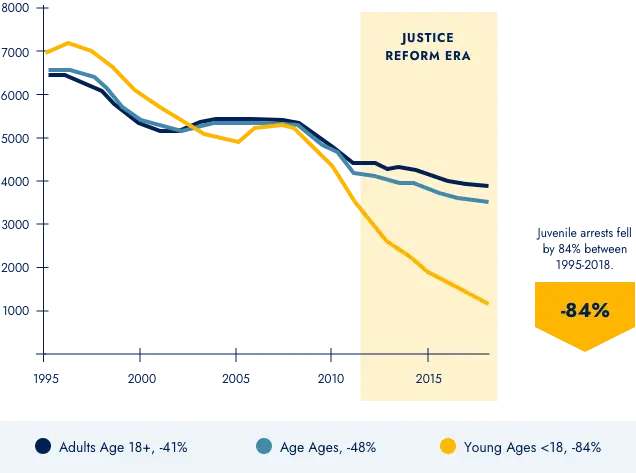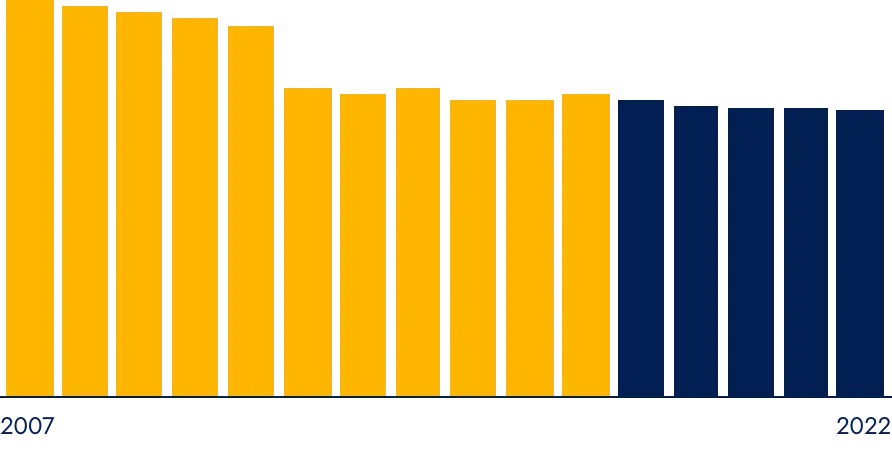
BHC partners on track to help end youth incarceration...
Policy Change
#EquityAndJustice Legislation for Youth (2016): Ten youth justice policies passed including barring children under 16 from being tried in adult court, children under 11 from being tried in juvenile court, life without parole sentences for youth, and court fees for youth & families.
AB 392 (2019): Required officers to use de-escalation methods like verbal persuasion and other crisis intervention methods to address threats instead of deadly force.
(2019): Governor announced commitment to ending youth incarceration and removed Division of Juvenile Justice from the CA Department of Corrections (CDCR).
Narrative Change

Local Impact
City Heights (2014): A restorative justice alternative to juvenile incarceration MOU established among San Diego Probation, District Attorney, Public Defender, SDUSD, and Juvenile Court.
Fresno (2016): Fresno Boys and Men of Color & Fresno Women Empowered successfully advocated for county eliminate fees associated with juvenile justice system contact.
South LA/Boyle Heights/long Beach (2018): LA County Probation Department announced plans to shut down six juvenile detention camps with aim of providing workforce & educational training, housing, and other community-based prevention services, instead.
Statewide Impact
California Arrests Per 100,000 Population by Age Group (1995-2018)

…and contributed to reducing mass incarceration, reimaging systems, and shifting power in California
BHC statewide contribution
Implementation of statewide justice reform policies such as AB 109, Prop 47 and 57, which:
- Ended “Three Strikes” law
- Reclassified & expanded parole consideration
- Offered release for low-level offenses
- Redirected systems savings to prevention and anti-recidivism efforts
INTERIM RESULTS INCLUDE:
- Up to 1M Californians eligible
- >300k petitions for resentencing & reclassification
- Funds shifted away from state prison system to community-based organizations (2017: $103M, 2018: $79M)
Impact of policies and policy implementation
Statewide adult incarceration decreased by 23% from 2007-2017.

BHC local leadership
TCE leadership led a LA County workgroup (Alternatives to Incarceration) that aims to scale alternatives to incarceration and diversion so care and services are provided first, and jail is a last resort.

These examples highlight the start of a shift in power across justice systems, as well as a pivot toward community alternatives.
Source: California Budget and Policy Center; “Unintended consequences of Prop. 47 pose challenge for criminal justice system, “LA Times; Alternatives to Incarceration workgroup website.
BHC partners aided in the protection of immigrants at the state- and local-levels
Board of Supervisors declined proposed ordinance to exempt county from SB 54, which ensured no state or local resources are used by federal agencies to carry out mass deportations and ensured hospitals, courthouses, and schools remain safe for all.
As a result of the City’s $300k funding, Family Unity, Education and Legal (FUEL) Network created to provide legal representation in court for residents.
Board of Supervisors approved a funding partnership with local philanthropy, including TCE, to launch Stand Together Contra Costa, a rapid response system to meet the needs of immigrants facing deportation in the county.
Creation of a county-wide, multi-sectoral rapid response network of immigration attorneys, immigrants’ rights advocates and academic institutions to provide support for incidents of arrests, detention and deportation proceedings.


Source: BHC Policy Inventory Tool, 2020; LA Times; Sacramento Bee; ACLU NorCal; NBC San Diego websites.
Community power resisted displacement and promoted affordable housing and other equitable initiatives
Statewide Policy Wins
Provided state funding for community-led infrastructure projects that achieve environmental, health and economic benefits in California’s most disadvantaged communities.
Passed in state legislature decriminalizing street vending and providing guidelines for jurisdictions to create permit systems; Provided amnesty on current citations, and protected vendors with existing tickets.
Assembly approved statewide rent control that barred landlords from hiking rents more than 5 percent, plus local inflation, in one year.
Local Policy Wins
City Council voted to approve a “Fair Chance Access to Affordable Housing” ordinance to protect the rights of people who are re-entering society and are excluded from housing opportunities due to their criminal record.
Anti-displacement organizing and advocacy pushed the passage of Measure Y, amending and strengthening the City’s Just Cause Eviction Ordinance to address landlord loopholes, removing the exemption for owner-occupied duplexes and triplexes and allowing council to add limitations on landlord’s rights to evict under the ordinance, without a future ballot measure.
City Council voted unanimously to approve and implement the Housing Element, which included the following recommendations: 1. Housing for Farmworkers; 2. Housing for the Undocumented; 3. Reducing Patterns of Housing Segregation; 4. Community-based Code Enforcement Strategy; and 5. Tenant’s Rights Education. Leveraged resources of $120k were allocated to the project.
Metro approved the Transit Oriented Communities Policy that committed LA Metro to achieving housing affordability and economic vitality in transit hubs across LA County.
City Council approved the Housing Opportunity Ordinance which allocated a portion of development dollars specifically for low-income, affordable housing.

Source: BHC Policy Inventory Tool, 2020; “California governor strengthens bill for statewide rent control,” Curbed LA, 2019.
BHC partners advanced environmental justice and equitable community development efforts…
 Clean Water Access
Clean Water Access
Eastern Coachella Valley (2015): Water4All Partnership with Coachella Valley Unified School District and community centers installed 33 hydration stations.
South Kern (2017): The City of Arvin received 170 point-of-use (POU) filters throughout Arvin Union School District, Arvin High School and Health Start programs, community clinics, and parks providing over 200,000 gallons of arsenic-free water to nearly 6,000 students and residents.
Merced (2017): Board of Supervisors approved its County Housing Element, which specifically included policies to address and respond to expressed farmworker housing needs, as well as priorities regarding wastewater and safe drinking water.
Statewide (2019): Passed Safe and Affordable Drinking Water Fund (SB 200), established a $130M to help local systems provide safe drinking water.
BHC Communities for Clean Water Access Note: The policy changes identified here reflect accomplishments championed by BHC participants during the initiative, but not necessarily with TCE funds. All TCE grants to BHC participants were made in compliance with the requirements of federal tax law.Source: BHC Policy Inventory Tool, 2020; “Gov. Gavin Newsom Signs Bill Creating Safe Drinking Water Fund,” Governor’s Office, 2019.
 Environmental Justice
Environmental Justice
South LA (2013): Grantee advocacy resulted in Environmental Protection Agency (EPA) investigation, a fine and a city lawsuit against an oil extraction site for falling to prevent the release of toxic chemicals in a residential community; facility was forced to close.
Fresno (2017): After years of advocating, community residents in West Fresno won the first key battle in the fight to relocate one of Fresno’s most egregious industrial polluters.
Statewide (2017): State legislature passed AB 617, the Community Air Protection Program which in 2018-19 awarded $5M in grants to improve air quality and reduce exposure to toxic air pollutants in California communities most impacted by air pollution.
South Kern (2018): Environmental Justice (EJ) advocates successfully advocated for the adoption of a new Oil and Gas Ordinance in the city of Arvin that created buffers between drills and residences, increased permit fees, and updated standards from 1965.
BHC Communities for Environmental Justice Note: The policy changes identified here reflect accomplishments championed by BHC participants during the initiative, but not necessarily with TCE funds. All TCE grants to BHC participants were made in compliance with the requirements of federal tax law.Source: BHC Policy Inventory Tool, 2020; “Gov. Gavin Newsom Signs Bill Creating Safe Drinking Water Fund,” Governor’s Office, 2019.
 Parks and Recreation
Parks and Recreation
Santa Ana (2012): $380k Pacific Electric Exercise Park opened in Santa Ana’s Madison Park neighborhood, funded by federal trail enchancement funds.
City Heights (2016): A $1M canyon restoration project in Manzanita Canyon promoted healthy behaviors and access to outdoor open green space for young people of color and their families in City Heights.
Eastern Coachella Valley (2018): Community of North Shore held its grand opening of a five-acre park, the culmination of a six-year community-led design process in partnership with BHC partners and Desert Recreation District.
Statewide (2018): Voters passed prop 68 (Parks and Water Bond Act of 2018) by 57.8%, which provided $4.1B in bonds for state and local parks, environmental protection and restoration projects, water infrastructure projects, and flood protection projects.
BHC Communities for Parks and Recreation Note: The policy changes identified here reflect accomplishments championed by BHC participants during the initiative, but not necessarily with TCE funds. All TCE grants to BHC participants were made in compliance with the requirements of federal tax law.Source: BHC Policy Inventory Tool, 2020; “Gov. Gavin Newsom Signs Bill Creating Safe Drinking Water Fund,” Governor’s Office, 2019.
 Active and Equitable Transportation
Active and Equitable Transportation
Eastern Oakland (2013): A multi-stakeholder alliance won campaign to improve transit in East Oakland, leveraging $180M in state and federal funds.
South Kern (2017): A collaboration between community groups residents and the Kern County Roads Department successfully secured $1.43M in Active Transportation Program dollars to improve walkability in the community.
South Sacramento (2018): SCUSD approved a ‘Safe Routes to School’ board policy, which recognized and promoted walking, bicycling, and other forms of alternative transportation to and from school in order to encourage active lifestyle, enhance student learning, and reduce vehicle traffic and air pollution.
BHC Communities for Transit Access Note: The policy changes identified here reflect accomplishments championed by BHC participants during the initiative, but not necessarily with TCE funds. All TCE grants to BHC participants were made in compliance with the requirements of federal tax law.
Source: BHC Policy Inventory Tool, 2020; “Gov. Gavin Newsom Signs Bill Creating Safe Drinking Water Fund,” Governor’s Office, 2019.
…and provided low-interest loans that yielded impact
Since inception, TCE’s Program Related Investments (PRIs) have provided $113M in mission-aligned, flexible, low-cost financing to support community facilitiees, small businesses, fresh food access, community health centers and affordable housing for low-income communities across California.
PRIs benefitted underserved communities throughout CA:
250,000 people projected to have increased access to community health centers and clinics.
609,000 square feet of health center and clinic facilities developed or renovated.
600,000+ square feet of health food access supported.
6,200 service-enriched and supportive housing units developed.
14,300 youth benefiting from youth development programs.
6.9x leverage ratio on PRIs from private, public and philanthropic capital.

$30M in PRIs to Community Health Centers
23 PRIs focused on increasing access, whole patient care, operational innovation.

$12.4M in PRIs; ~$8.5M in Grants
Lifted California’s focus on fresh food access through an innovative financing / TA model; 800,000+ people served.

$5M in PRIs; $500k in Grants
Supported growth and capacity of highly BHC-aligned lender in LA.
More About Health Happens in Neighborhoods
Statewide Context Timeline
Click here for a digital timeline that highlights the statewide context, contributions, and policy changes informed and supported by our Building Healthy Communities partners that are connected to the 2010-2020 BHC Dashboard Summary.
BHC Communities Interactive Map
Click here for a digital map that highlights many local achievements championed by our 14 Building Healthy Community sites that are connected to the 2010-2020 BHC Dashboard Summary.
Unveiling Our 2024 Annual Report
The California Endowment is proud to present our 2024 annual report. Read about the work we are supporting and our partners who are changing California to a state of belonging and inclusion.
View Report

Brenda Solórzano: Meet Our New President and CEO
The California Endowment’s new President and CEO joined CalEndow Live on November 19 to share her thoughts on philanthropy, her hopes for California, and her excitement about returning to her home state. This hourlong conversation highlighted many of the most important issues facing California and featured great questions submitted by our live virtual audience.
Watch Recording